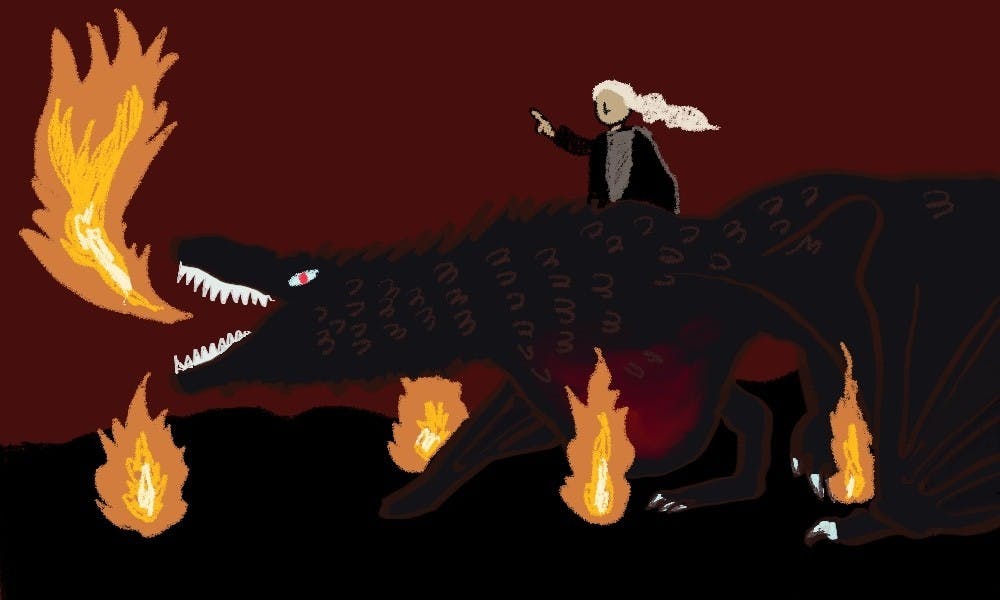Imagine Disney+ or Kevin Feige doing a Game of Thrones prequel about House Targaryen. There would be more dragons, for sure. An amusing tour of the dragon pit with a flippant guide is warranted in the first ten minutes of the pilot, including several self–referential jokes. They might even have two dragons spew fire at each other, although no one would be harmed by the end of the episode.
Luckily, that’s not the case. HBO’s highly anticipated spinoff series House of the Dragon, which premiered on Aug. 21, has brought back the glory of Game of Thrones. Set in the world of Westeros 172 years before the birth of Daenerys Targaryen, the show follows an internal succession war within House Targaryen at the absolute height of its power. With ambition and uncontested quality, House of the Dragon has intelligently learned from the catastrophic conclusion of its parent show and single handedly raised the standards for what a high–budget fantasy TV series can look like.
Despite the cascade of negative reviews on the final few episodes of Game of Thrones, the seed to its failure does not lie in the few shocking moments of the last season, but as soon as the series suddenly picked up its pace from season five. Characters began roaming around Westeros without a reasonable time frame. Meticulous narratives and foreshadowings gave way to shock–value deaths. And thus a precious sense of realness, constructed and perfected after years of detail, was carelessly destroyed. Vivid characters were degraded into chess pieces on a sand table, manipulated by show–runners David Benioff and D.B.Weiss, to hurdle across the finish line. The task of world–building, in this sense, is utterly abandoned.
Though building upon an already–successful worldview, House of the Dragon has patiently devoted ample screen time to lay the groundwork and perfect the bizarre world of Westeros. Take dragons, again, as an example. The series has firmly refused to treat the beast as an eye–catching feature only to demonstrate its VFX strength; rather, it has diligently created the yesterday–world where dragons used to dominate the land. The only spectacle reliant on special effects from the pilot is the one–minute opening when Rhaenyra rides the dragon into King’s Landing. What follows is the real, rare spectacle found in the show. When her dragon flies above the city, passersby are perfectly composed, disregardful of the giant beast. As it lands in front of the pit with freshly consumed animal bones, a master and his apprentice are guiding and training the dragon with specially crafted sticks. Even into the palace, the design of dragons is seen everywhere, with each room and hallway decorated with erotic murals that visualize interactions between humans and dragons to demonstrate the current era’s prosperity and decadence. Instead of presumptuously adding dragons into the show, the series establishes an ecosystem around it and, thus, a functioning diegetic world.
World building is an essential task, which ensures a story is naturally happening rather than being constructed. It’s worth noting that building a world is not the same as randomly assigning goofy cameos and flimsy easter eggs that share no actual significance; you can only do that a few times before a film or TV series becomes an inside–joke celebration or a megafan event. World building is about the mundane, everyday details and how they unfold, including institutions (court, small council, tavern, and brothel) and ceremonies (tournaments, hunting, wedding). And on such baselines of the world, the seeds to instability, madness, and warfare are sown. It is also about trusting the audience and not force–feeding them crucial information. You don’t want someone saying out loud, for example, that Viserys (the current king), though good–hearted, is not fit to wear the crown. All you need is an inadvertent cut by the throne’s swords and a festering wound that refuses to heal. This is the kind of detail that builds a fantasy world and promises a successful multi–season TV show.
Whether you’re an utterly disappointed Game of Thrones fan, or a newcomer at the gates of Westeros, this is your time to enter or re–enter the world. When I thought the exquisitely executed and tragic parallel montage between the tournament and the childbirth would be the peak of the pilot, I did not expect the sublime ending: when Viserys decides to name Rhaenyra, his daughter, as the new heir to the Iron Throne. As HBO Chief Content Officer Casey Bloys commented, “You want to make a show that feels related and honors the original, but also feels like its own.” Intending not to cheaply drain on its IP value, House of the Dragon is undoubtedly reserved in connecting itself to Game of Thrones. But the show has managed to pay homage to the original in an earnest, dignified way: a distant dream told by Viserys that serves as a reference to the book series, A Song of Ice and Fire.
When Ramin Djawadi, the music composer for both Game of Thrones and House of the Dragon, brings back his iconic main theme for Game of Thrones in the last few seconds of the pilot, one can know for certain that the very world that once moved and devastated them is gracefully back, with much more to offer.

